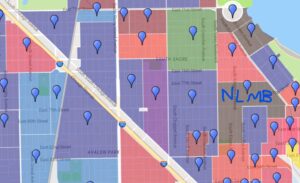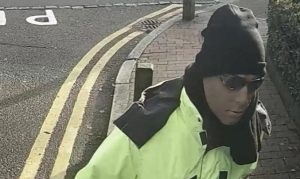As Trump sends National Guard into Chicago, Traplore Ross talks us through Chicago’s gang wars
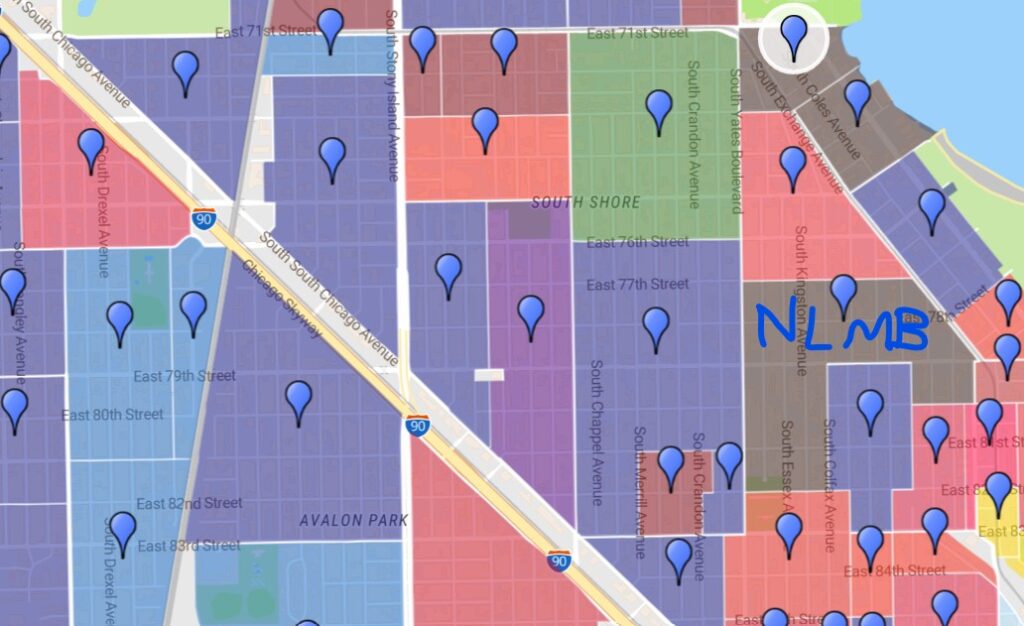
Subscribe for free for twice-weekly true crime articles or become a paid subscriber to get premium content – https://totalcrime.substack.com/
By Chris Summers 29 October 2025
US President Donald Trump this month tried to deploy 700 National Guard troops to Chicago, partly to take on the city’s notoriously violent gangs.
On 2 July a drive-by shooting at an album release party by rapper Mello Buckzz (pictured below, left) – who is affiliated with one of Chicago’s most notorious gangs – claimed the lives of four people, including her boyfriend Devonte Williamson (pictured below, right).
Here I explore the gangs of Chicago – the city where drill was born – with the help of YouTuber and rap music expert Traplore Ross.

In 2009 rapper King Louie coined the term Chiraq – an agglomeration of Chirago and Iraq – to denote the most violent neighbourhoods of the city, which sits on the south west corner of Lake Michigan.
I’ve never been to Chicago but I have been wanting to write about the city’s gangs for a long time.
Until now I could never find a good enough “peg” – that’s a term us journalists use for an event which you can hang a news feature on.
Then, on 2 July this year, 18 people were shot outside a party being held by rapper Mello Buckzz in Chicago’s River North district.
Four of those 18 died.
They have been named as 23-year-old Williamson, (pictured below, left), Leon Henry, 25 (bottom), Taylor Walker, 26 (right), and Aviance King, 27 (top).
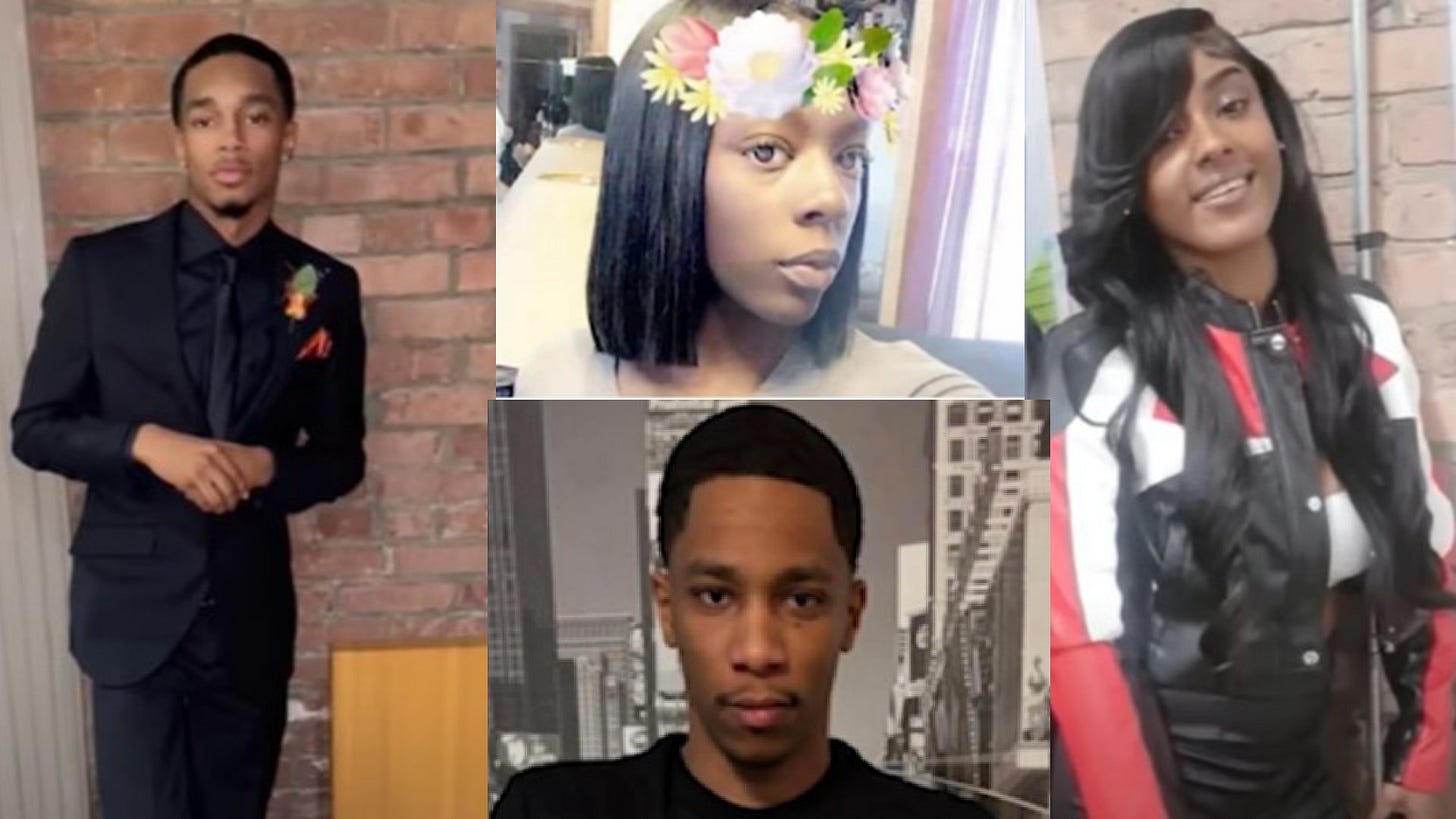
That was going to be my original peg.
But then three months later Trump sent in the National Guard, only to be accused of “attempting to manufacture a crisis” by several Democrat politicians, including the Governor of Illinois, JB Pritzker, who have taken the White House to court.
Pritzker is a billionaire who it turns out won $1.4 million playing blackjack in Las Vegas last year.
All in all, now seems like a good time to finally write about Chicago’s drill scene, and the gangs whose bullet-ridden escapades fuel much of the lyrics.
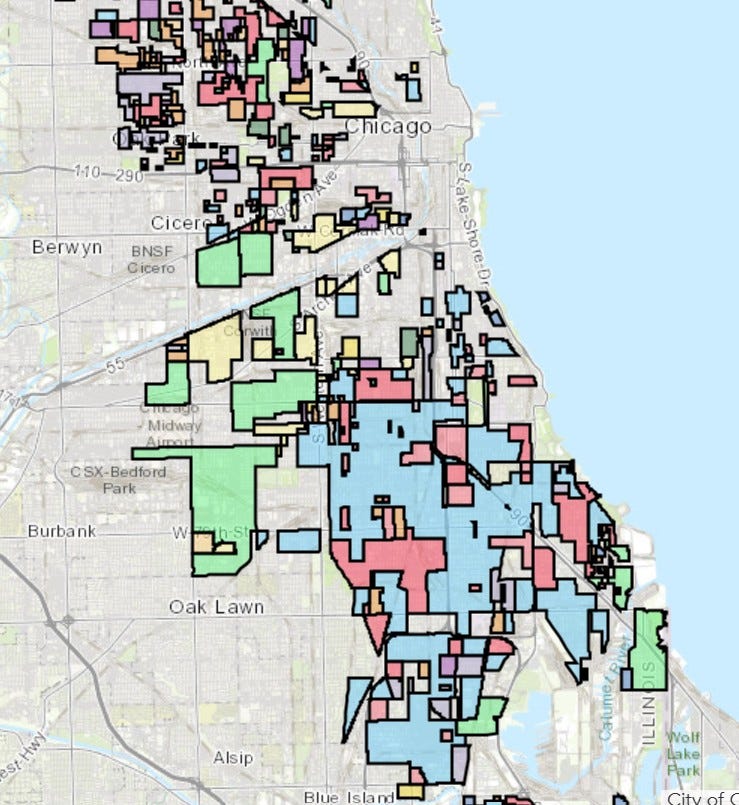
And who better to give me a guided tour of the Windy City’s gangs and rappers than Traplore Ross.
Now Traplore Ross – a middle class English guy, who grew up in the quaint seaside resort of Bognor Regis – is not to everyone’s taste, and I know he has his detractors on Reddit, where he has been accused of being everything from a “nerd” to an “informant”.
But one thing is not in doubt – he knows his stuff.
He styles himself a “hip hop historian” but in recent years, with the growth of drill, that has meant becoming an expert in the gangs of Chicago, London and to a lesser degree other US cities.
Now I know plenty about London’s gangs – and I also know a fair bit about gangs in Los Angeles, which gave birth to The Bloods and The Crips, two of the most infamous gang brand names in the world.
Some of you may know that in the summer of 2003 – while on holiday in California – I interviewed Stanley “Tookie” Williams, the co-founder of The Crips, who was on Death Row in San Quentin prison.
Tookie was executed two years later, on the orders of California’s then Governor, Arnold Schwarzenegger.
On that same trip I was given a guided tour of South Central L.A., including a district known as The Jungles in Baldwin Village, and shown street corners where people are regularly killed for wearing the wrong colour clothes – red is famously associated with the Bloods, blue for the Crips.
The Crips were founded around 1969, and The Bloods a couple of years later.
But it turns out that Chicago’s gang history goes back even earlier.
The Blackstone Rangers – named after Blackstone Avenue on Chicago’s Southside – later morphed into the Black P Stone Nation.
One of its original leaders, Eugene Hairston, was murdered in 1988.
That same year the gang’s co-founder, Jeff Fort, who had set up an Islamic spin-off called the El Rukns, was given a life sentence for a 1981 murder and remains incarcerated in a supermax prison in Florence, Colorado.
Then there’s the Black Disciples and the Gangster Disciples, rival gangs set up in the 1960s by David Barksdale and Larry Hoover respectively.
Barksdale, aka King David, was shot six times in 1968. He survived but died of his injuries in 1974.
Hoover – who is said to have had 30,000 Gangster Disciple soldiers in 35 states – was given three life sentences by a federal court in 1995.
But earlier this year President Trump commuted his life sentence, but he is still serving a 200-year sentence imposed by the state of Illinois.
According to this BBC article, Hoover wrote a letter to the court in 2022 saying: “I am no longer a member, leader, or even an elder statesman of the Gangster Disciples. I want nothing to do with it now and forever.”
So, let’s get back to present day Chicago.
Now I am not going to deny that much of my information for this piece comes from Traplore Ross, especially a chat that we had on YouTube last week.
But I am going to focus on the events which interested me most – the shooting at the Mello Buckzz album party on 2 July.
Buckzz – real name Melanie Doyle – was celebrating the release of her latest album “Hollyhood”.
Now the shooting took place at 11pm outside the Art-is Restaurant & Lounge, which has since closed down.

Three years earlier, in November 2022 – when the same venue was called Hush Chicago – one man was killed and three injured when a brawl outside turned into a shootout.
Traplore Ross did an excellent breakdown of the murders, (see below) on YouTube, where he points out that members of the No Limit and Muskegon Boys gangs (together known as NLMB) had been mercilessly taunting members of the 95 gang after one of their members, known as Drillz, was shot earlier on 2 July.
Drillz – real name Ronald McClain, 29 – was gunned down in the West Pullman area of the Southside.
Traplore Ross pointed out that earlier in the evening, Mello – who claims to be affiliated with NLMB – posted on social media: “I’m at the party where the shooters at.”
Mello Buckzz references “NLMB” on her Facebook page.
NLMB has its roots in both the Black P Stones and the Gangster Disciples.
Prominent drill rapper G Herbo is a leading figure of the gang, and featured on a track on Mello’s new album.
After the shooting Mello wrote on her Instagram page: “My heart broke into so many pieces…I don’t wish this typa pain on nobody.”
“My heart breaking into so many pieces rn ts unbelievable,” she added.
Her Instagram profile, and her Facebook page, have the title “Pretty opp”.
On July 16 – the day of her best friend Taylor Walker’s funeral – Mello posted: “Today I laid my sister to rest so in Honor of her here’s Super P Official Video out NOWWW. In loving Memory of Tay Tay.”
In response to Mello’s Instagram posts the rapper YFG Fatso, who is associated with rival gangs, had a go at her for “crying” about the loss of her people and said he would not cry when his people were – inevitably – killed.
But it’s not just the dead that we need to remember.
Fourteen people – all in their 20s or early 30s – were shot and wounded on 2 July.
Some may have been no more than a grazing, but several of them are likely to have suffered a life-changing injury.
It is interesting to note that a week after the shooting the rapper’s father, Melvin Doyle, was indicted on totally unconnected federal gun charges after allegedly selling a Glock pistol to undercover ATF agents for $800.
Doyle, a convicted felon, allegedly sold 13 firearms illegally during the investigation, all from his home on the Southside.
As for the shooting at her album release party, more than three months have gone by and it appears that nobody has been arrested – let alone charged, for the crime.
Usually in these situations a gang would retaliate against whoever they believed was responsible, in this case probably the 95th Street gang, who are closely allied with Risky Road.
Other enemies of NLMB including a gang from the Pockettown district of the Southside, and the KTS (Kill To Survive) gang.
Rapper Big Mexx from Pockettown was killed in March 2025, and NLMB may have been responsible.
KTS is a faction of the Gangster Disciples and in July 2021 its most notorious rapper, KTS Dre (pictured below), was gunned down as he walked out of Cook County jail.
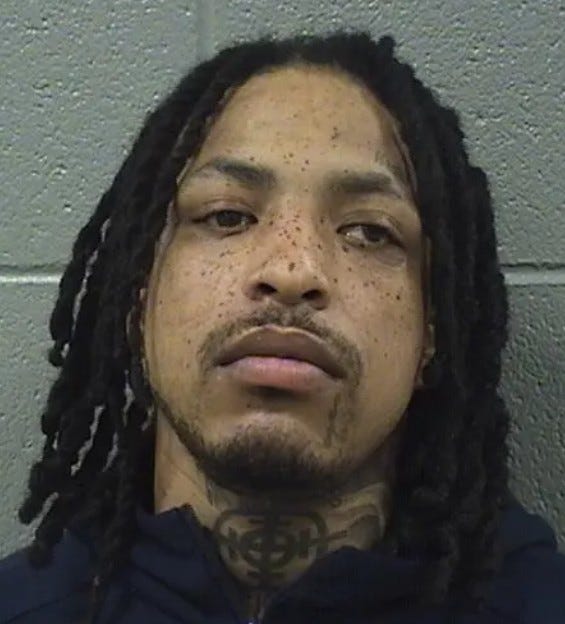
His fiance had put up the $5,000 bail money but 31-year-old KTS Dre (real name Londre Sylvester) was mown down by around 60 bullets fired by two gunmen in a drive-by shooting in South California Avenue.
The case remains unsolved, although it appears “even the dogs on the street” in Chicago know NLMB was responsible.
Sylvester’s brother, KTS Von, was also killed in June 2015.
But one reason why the NLMB – which also stands for Never Leave My Brothers – have not responded could be because of an internecine feud which has broken out.
In late September a rapper called J Dogg – who had only recently been released from prison – was shot dead after calling out G Herbo.
Traplore Ross told me: “So rumour has it that J Dogg came out of jail and wanted to press the line, and tell people what they could and couldn’t do.”
He said J Dogg made a post on social media which disrespected G Herbo and said the rapper could not come back to the block.
Big Opp, an underling of G Herbo and a major figure in NLMB, responded by saying: “No-one’s going to tell G Herbo where he can and can’t go.”
Traplore Ross said Big Opp made a “very ominous” statement saying: “If you’ve got problems with that, you’ll have to talk to God about it.”
And about 10 days later J Dogg is found dead.
Traplore Ross said the NLMB was now riven by divisions, with the younger generation splitting into two factions – The Drench gang, who are loyal to G Herbo, and The Boss gang (not to be confused with the Goonie Boss gang, from Englewood) who followed J Dogg.
“There’s lot of rumours that the younger members, that were loyal to J Dogg are now going to be going to war with Big Opp and G Herbo. They’ve got this really bad internal war going on at the moment, and that’s kind of, that’s kind of preoccupying them,” he told me.
Traplore Ross told me NLMB was so big that the only way to take it down might be by a RICO indictment.
I wrote this Substack back in May about Minneapolis gangs, two of whom – The Highs and The Bloods – were taken down by a RICO indictment in 2023.
As most people know drill began in Chicago, around 2012, before coming to London a couple of years later and then, spreading around the world, including back to US cities like New York.
Traplore Ross told me: “Chicago drill music really pioneered drill music. It was essentially kind of an evolution of Atlanta trap music.”
He said artists like Gucci Mane, Waka Flocka Flame and OJ da Juiceman, were making songs mainly about drug dealing, and when it came to Chicago the lyrics became more violent, reflecting the madness on the city’s streets, especially in the Southside.
“What was going on in Chicago was incredibly violent during this time,” Traplore Ross told me, “and Chief Keef popularised drill music. He became the biggest drill artist.”
Chief Keef hailed from the Parkway Gardens housing project, otherwise known as O’Block, as did King Von, who was affiliated with the Black Disciples.
King Von’s last album, Welcome to O’Block, came out on 30 October 2020 and a week later he was dead, gunned down at the age of 26 outside a hookah lounge in Atlanta by a member of local rapper Quando Rondo’s crew.
The shooter was later identified as Timothy “Lul Timm” Leeks, but in August 2023 charges against him were dropped because of Georgia’s “stand your ground” law, which is a form of self-defence.
In October 2024 King Von’s close friend, fellow Chicago rapper Lil Durk was arrested on suspicion of hiring a hitman in 2022 to kill Quando Rondo in revenge. The hit went awry, and the Atlanta rapper’s cousin, Savaiya “Lul Pub” Robinson was killed.
Lil Durk, 33, is still in prison awaiting a trial in January 2026 but that has not stopped him bringing out a ninth album, Deepest Thoughts – which was recorded before he was incarcerated.
Drill music – which has since been exported from Chicago to London, Ireland, Sweden, Australia and all over the world – thrives on beefs.
Traplore Ross pointed to the case of rapper Blasian Doll, whose mother was killed.
“There’s been a lot of rumours about who might have been responsible, and her gang have had a lot of back and forth with Welch World [a gang whose territory is bounded by 40th Street and Cottage Grove, and 43rd Street and King Drive] .”
But earlier this year Blasian Doll squashed the beef, but forgiving Tay Savage, a rapper and leading member of Welch World.
Traplore Ross said that Mello Buckzz (pictured below) then mocked Blasian Doll for forgiving the people who had killed her mother, and Blasian Doll responded by making an Instagram post saying, “Oh, well, you haven’t done anything since Risky Road shot up your party.”
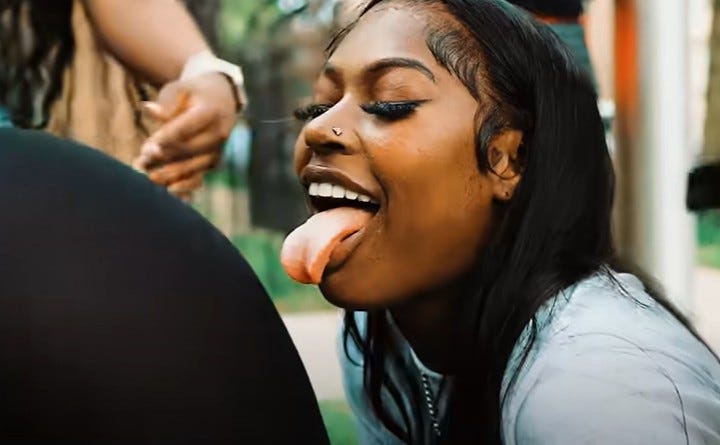
He said Risky Road was a very notorious gang in Chicago and he said Blasian Doll’s post was the first time that anybody had pointed a finger at them for the 2 July party shooting.
“Now what’s interesting is Risky Road doesn’t really have a hugely deep history with No Limit,” he said.
But the beefs within drill which lead to constant violence enrages many black Americans, in Chicago and elsewhere.
A guy calling himself ilstateflipper wrote on Mello Buckzz’s Instagram page, shortly after the party shooting: “Drill music is genocide amongst our people. Black people talking about killing other blacks …this type of music would never be played in other cultures or communities. We’re the other culture that allows our artists to talk about harming other blacks.”
I contacted ilstateflipper and he told me he is black and lives in the suburbs of Chicago.
He told me he classified drill “as genocide because it’s one of the leading cause of death among young black men in the inner cities.”
Ilstateflipper said: “It’s very nature is violent and addictive. Almost like a drug, but to better describe it, a cancer or a parasite.”
“It has no benefit in society and carries nothing but evil amongst our people. No other race share similarity in this form of genre music… Nor would it ever be glorified or played publicly if it was any other race,” he added.





